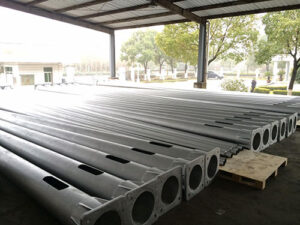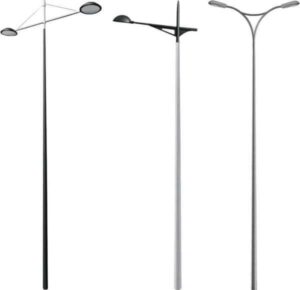According to different materials, the lampposts can be divided into iron lampposts, FRP composite lighting poles, cement lamp poles and aluminum alloy lampposts.
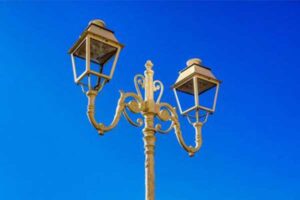
Iron Lampposts
The Advantages and Disadvantages of Iron Lampposts
Iron lamppost is of high strength, with the following shortcomings:
1. Easy corrosion rust
2. Three times weight then aluminum, high cost of transportation and installation cost
3. Limited recycling value
4. Insertion installation method impossible to be applied
5. Surface treatment is monotonous.
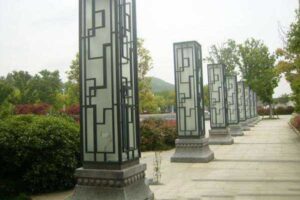
Cement Lampposts
The Advantages and Disadvantages of Cement Lampposts
The advantages of cement lampposts are as follows:
1. Plug-in installation can be adopted
2. Strength is good
3. No spraying is needed.
Shortcomings of cement lamppost:
1. Very heavy, very expensive transportation costs
2. No recovery value
3. Installation equipment is expensive, difficult to install
4. More dangerous than other materials.
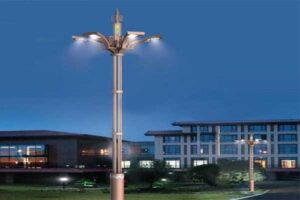
Aluminum Alloy Lampposts
The Advantages and Disadvantages of Aluminum Alloy Lampposts
Advantages:
1. Good corrosion resistance
2. Maintenance free
3. Light weight, convenient transportation and installation
4. A lot of surface treatment methods available
5. Longer life time than the iron pole and glass steel pole
6. 100% recovery, and low melting temperature, energy saving and emission reduction
7. Insertion is applied
8. Smaller amplitude than fiberglass lamppost.
Disadvantages of aluminum alloy lampposts: compared to iron lampposts, the strength of aluminum alloy lampposts is relatively low, but can reach the standard of T6 by the heat treatment later.
Because of many unparalleled advantages, aluminum alloy lampposts have been used very commonly in developed countries such as Europe and America. While It is still in its initial stage currently in China.
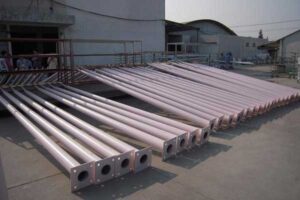
Fiberglass Lampposts
The Advantages and Disadvantages of Fiberglass Lampposts
1. Light weight and high strength: the strength of FRP material is the same as that of advanced alloy steel. Its density is 1.5~2.0, which is 1/4~1/5 of carbon steel and its tensile strength is equivalent. Therefore, based on the same specification, the weight is about 1/3 of the steel bar. Based on this characteristic, the fiberglass composite lighting pole is especially suitable for bridges etc. where has the load requirement.
2. Corrosion resistance: fiberglass is a good anti-corrosion material for the air, water and the general concentration of acid, alkali, salt, and a variety of oils and solvents. Therefore, FRP lighting poles can be well adapted in the moist and rainy coastal cities with high salt content. There will be no noticeable changes in appearance and interior during the whole life cycle of lampposts. This is incomparable.
3. Good insulation properties: fiberglass as a good insulating material, can be used in the production of insulator. Therefore, during the operation of FRP light pole, there will be no electric shock and human injury caused by electric leakage. Although metal lampposts are equipped with earthing protection devices, they can never be foolproof. Therefore, glass fiber reinforced plastic lampposts have certain advantages in high safety requirements (such as sidewalks, parks).
4. Free maintenance: because of its corrosion resistance, fiberglass reinforced lamp pole does not need to be maintained throughout the cycle of use. Since a kind of special spraying coating is applied for its surface to ensure that it will not fade in ten years. Its advantages is highlighted under the situation that maintenance funds are relatively scarce.
5. Smooth and beautiful surface: the surface of the fiberglass lampposts has a good affinity with the coating material of the outer layer, so the surface of the FRP lamp post is very smooth and more beautiful than the ordinary steel post.
6. Low installation cost: Because of its light weight, fiberglass reinforced plastic lamppost does not require a crane for installation. It is simple and quick when installed, with little influence on traffic. In the street lamp project, the labor cost accounts for about 20%~30% of the total cost. If FRP poles applied, cost can be effectively reduced.
7. Strong windproof ability: the fiberglass material has a slight elasticity, and the fiberglass lamp pole has approx. 10% of the amplitude when the typhoon comes, but this is just plastic deformation. It can return to its original position after typhoon. The principle of wind resistance is similar to that of bamboo.
Fiberglass lamppost shortcomings:
1. Short service life
2. No recovery value due to its difficulty and high cost
3. UV damage to the post is very serious
4. Maintenance costs too much
5. Easy to be damaged by external instruments.
